Anemone ranunculoides
YELLOW ANEMONE
- Unit price
- / per
Anemonoides ranunculoides is know as the yellow anemone, yellow wood anemone, or buttercup anemone. It is a species of herbaceous and perennial plant that grows in forests. The native range of Anemonoides ranunculoides extends across Continental Europe to southwest Siberia, reaching as far south as the Caucasus Mountains in Turkey. The species has been introduced into Great Britain and elsewhere. In Canada, there is a naturalized population at a well-known site in Quebec.
The rhizomes spread just below the soil surface and multiply quickly, contributing to its rapid spread in woodland conditions. The flower is of rich yellow colouring. In its native range, it flowers between March and May.
The plant is widely grown as a garden plant, especially by rock garden and alpine garden enthusiasts. It has been awarded an Award of Garden Merit or AGM by the Royal Horticultural Society.
Type: Hardy perennial
Hardiness zones: 3-9
Height: 15cm, 6"
Location: Shade or part shade
Seeds per packet: 20
Sow just under the surface of the soil and water in. Temperature 20-22 C (68-72 F) for 4 weeks. They may be growing at this point. If they have not germinated after 4 weeks then a cooling period is required. Cover them with plastic and place in a fridge for 4 weeks. Be sure they stay moist. After the stratification period they are then brought back to room temperature for them to germinate. Germination can be 30-60 days after the warming period, though some can take longer.
Ornamental use only. These seeds and plants are poisonous.
Anemone ranunculoides
YELLOW ANEMONE
- Unit price
- / per
Multiple secure payment options available.
Adding product to your cart
You may also like
Anemonoides ranunculoides is know as the yellow anemone, yellow wood anemone, or buttercup anemone. It is a species of herbaceous and perennial plant that grows in forests. The native range of Anemonoides ranunculoides extends across Continental Europe to southwest Siberia, reaching as far south as the Caucasus Mountains in Turkey. The species has been introduced into Great Britain and elsewhere. In Canada, there is a naturalized population at a well-known site in Quebec.
The rhizomes spread just below the soil surface and multiply quickly, contributing to its rapid spread in woodland conditions. The flower is of rich yellow colouring. In its native range, it flowers between March and May.
The plant is widely grown as a garden plant, especially by rock garden and alpine garden enthusiasts. It has been awarded an Award of Garden Merit or AGM by the Royal Horticultural Society.
Type: Hardy perennial
Hardiness zones: 3-9
Height: 15cm, 6"
Location: Shade or part shade
Seeds per packet: 20
Sow just under the surface of the soil and water in. Temperature 20-22 C (68-72 F) for 4 weeks. They may be growing at this point. If they have not germinated after 4 weeks then a cooling period is required. Cover them with plastic and place in a fridge for 4 weeks. Be sure they stay moist. After the stratification period they are then brought back to room temperature for them to germinate. Germination can be 30-60 days after the warming period, though some can take longer.
Ornamental use only. These seeds and plants are poisonous.
















































